For some of us sand and concrete are just too expensive, stressful, and a big commitment, But there
are other alternatives, some coming at no cost. This time of year especially, good clean bedding is a
must. In this two part series I will be covering bedding, different types, maintaining it, and Keeping it
dry and healthy and fresh. Here are the materials I have used.
Bedding types:
Straw

Pros: Readily available, easy to fork up afterward, makes great compost later on.
Cons: Can be hard to spread, course, dusty, can harbor pests.
Because it is course and often dusty, it is not an ideal bedding to use inside your coop, especially
if it is poorly ventilated. Since most straw still contains grain, chickens love to scratch in it. Putting a bale of
straw in you coop or run is a good way to help with boredom. Because it is so course, straw can
also be great for controlling mud in and around your run. Some people report having more lice and
mite problems while using straw because of its tube like structure can be a prefect breeding ground
for these and other pests. It is also much to course for comfortable nesting boxes.
My rating
For interior use: ✯✯
Exterior use: ✯✯✯✯
Nest boxes: ✯

Hay

Pros: Readily available, soft, easy to fork and spread, mats together well.
Cons: Can be dusty, moldy, and expensive.
High quality hay can add an excellent fresh smell too your coop and run, but like straw, I would not recommend using
it unless your coop is well ventilated as even the best hay can be very dusty. It can be excellent for open runs though,
but is not as good for mud control as straw. It is great for nest boxes, especially if you
have screened bottoms, where shavings are not an option. Also it mats together well, making cleaning a breeze.
Chickens enjoy scratching in it, but be warned, hay contains lots of weed seeds so be careful if you plan to use
it for compost later on.
My rating
Interior use: ✯✯✯
Exterior use: ✯✯✯
Nest boxes: ✯✯✯✯
Pine straw

Pros: No dust, smells wonderful, free, Pest resistant.
Cons: Not available in some places.
Pine straw are one of my personal favorite bedding materials. They smell wonderful, and are readily available
in most places for no cost. It is great for inside your coop, especially if it is poorly ventilated as it is dust free.
Pine straw is great for runs as well, in fact some of us have pine trees already growing in our runs, supplying
then with fresh bedding with out any work on our part. If you do not have any pine trees on your property,
don't despair. There are many people with pine trees in their yards who would be happy to have them raked
up for free. Pine straw is ok for nest boxes, but not the most comfortable thing.
My rating
Interior: ✯✯✯✯✯
Exterior: ✯✯✯✯
Nest boxes: ✯✯✯

Pine shavings

Pros: Readily available, easy to spread, absorbent, great for brooders, pest resistant.
Cons: Can be dusty, hard to clean up later.
Pine shavings are easy to spread, and readily available, making them very stress free which is nice.
They aren't so good for large runs though, especially as they readily sink in to the mud. They are
good for nest boxes as long as you have a solid bottom. For brooders though, they are one of the
best materials to use, since they are fine, and there is nothing for the chicks to get caught on
(a problem with using hay are straw). Be careful not to use shavings that are too fine though, as the
chicks may try to eat them. You can buy shavings at your local feed or hardware store,
or possibly find free/cheap shavings at a near by saw mill.
My rating
Interior: ★★★★
Exterior: ★★★
Nest boxes: ★★★

Leaves

Pros: Free and readily available, No dust.
Cons: blow around a lot, hard to clean up later.
Because they are free and almost everyone has them in their yard, leaves are a pretty obvious thing to
use for bedding. Problem is, they like to blow around. Put them on one end of your coop, and they will
soon be scratched to the lowest end. For runs though, a load of leaves can be very beneficial, as
the chickens love scratching in them, gobbling up the worms and slugs that inevitably will find.
Throw a hand full of leaves in your brooder and you will have very happy chicks.
Also, leaves are nice and comfy, great for nest boxes.
My rating
Interior: ★★
Exterior: ★★★
Nest boxes: ★★★★

Wood chips

Pros: Cheap or free, no dust, absorbent, pest resistant.
Cons: Can be hard to find, hard to clean up later.
Wood chips or shredded trees, can make great bedding. They are dust free, and the chickens cannot
scratch them around like they can with other light materials like hay, leaves, or grass clippings.
Wood chips contain the whole tree, leaves, twigs and all, and makes fantastic mulch if let rot down. It is also great
for muddy pathways and runs. Finding wood chips can be hard. Your local electric company cuts and shreds
loads of wood chips every day if you are interested in getting large quantity's of them. Since wood chips are often
filled with large sticks and twigs, they are not good for nest boxes.
My rating
Interior: ★★★★★
Exterior: ★★★★★
Nest boxes: ★

Grass clippings

Pros: Free, smells good, chickens favorite.
Cons: Tough grasses can get stuck in chickens throats.
Grass clippings can be great bedding for your coop. Especially since chickens love to scratch and eat them
too. And they are free. Do not use clippings from tough grasses such as broom sedge or Fesque though,
as it can get stuck in your birds throats. Also, NEVER use clippings from grass that has been treated
with chemical fertilizers and pesticides, as it can be harmful or deadly to your birds.
My rating
Interior: ★★★
Exterior: ★★★
Nest boxes: ★★
Special thanks to Mountain peeps for letting me use her pictures!
Click here for part 2: https://www.backyardchickens.com/a/bedding-part-2-maintaining-your-bedding
Thanks for reading!
are other alternatives, some coming at no cost. This time of year especially, good clean bedding is a
must. In this two part series I will be covering bedding, different types, maintaining it, and Keeping it
dry and healthy and fresh. Here are the materials I have used.
Bedding types:
Straw
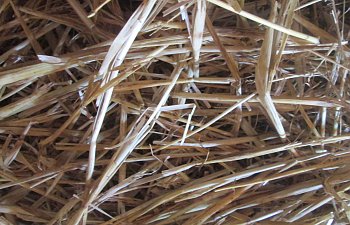
Pros: Readily available, easy to fork up afterward, makes great compost later on.
Cons: Can be hard to spread, course, dusty, can harbor pests.
Because it is course and often dusty, it is not an ideal bedding to use inside your coop, especially
if it is poorly ventilated. Since most straw still contains grain, chickens love to scratch in it. Putting a bale of
straw in you coop or run is a good way to help with boredom. Because it is so course, straw can
also be great for controlling mud in and around your run. Some people report having more lice and
mite problems while using straw because of its tube like structure can be a prefect breeding ground
for these and other pests. It is also much to course for comfortable nesting boxes.
My rating
For interior use: ✯✯
Exterior use: ✯✯✯✯
Nest boxes: ✯
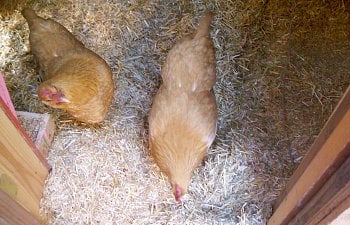
Hay
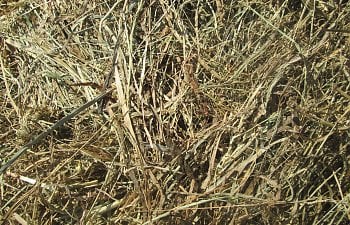
Pros: Readily available, soft, easy to fork and spread, mats together well.
Cons: Can be dusty, moldy, and expensive.
High quality hay can add an excellent fresh smell too your coop and run, but like straw, I would not recommend using
it unless your coop is well ventilated as even the best hay can be very dusty. It can be excellent for open runs though,
but is not as good for mud control as straw. It is great for nest boxes, especially if you
have screened bottoms, where shavings are not an option. Also it mats together well, making cleaning a breeze.
Chickens enjoy scratching in it, but be warned, hay contains lots of weed seeds so be careful if you plan to use
it for compost later on.
My rating
Interior use: ✯✯✯
Exterior use: ✯✯✯
Nest boxes: ✯✯✯✯
Pine straw
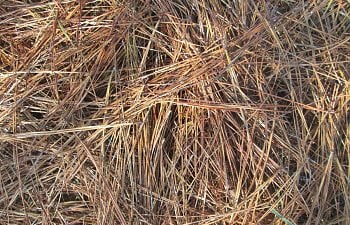
Pros: No dust, smells wonderful, free, Pest resistant.
Cons: Not available in some places.
Pine straw are one of my personal favorite bedding materials. They smell wonderful, and are readily available
in most places for no cost. It is great for inside your coop, especially if it is poorly ventilated as it is dust free.
Pine straw is great for runs as well, in fact some of us have pine trees already growing in our runs, supplying
then with fresh bedding with out any work on our part. If you do not have any pine trees on your property,
don't despair. There are many people with pine trees in their yards who would be happy to have them raked
up for free. Pine straw is ok for nest boxes, but not the most comfortable thing.
My rating
Interior: ✯✯✯✯✯
Exterior: ✯✯✯✯
Nest boxes: ✯✯✯
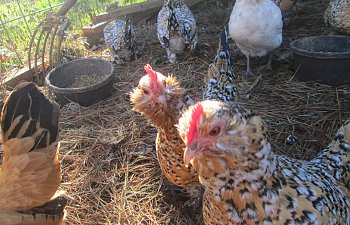
Pine shavings
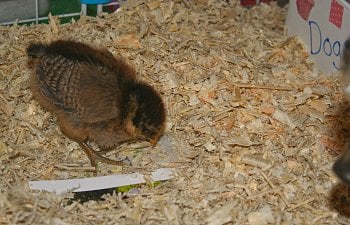
Pros: Readily available, easy to spread, absorbent, great for brooders, pest resistant.
Cons: Can be dusty, hard to clean up later.
Pine shavings are easy to spread, and readily available, making them very stress free which is nice.
They aren't so good for large runs though, especially as they readily sink in to the mud. They are
good for nest boxes as long as you have a solid bottom. For brooders though, they are one of the
best materials to use, since they are fine, and there is nothing for the chicks to get caught on
(a problem with using hay are straw). Be careful not to use shavings that are too fine though, as the
chicks may try to eat them. You can buy shavings at your local feed or hardware store,
or possibly find free/cheap shavings at a near by saw mill.
My rating
Interior: ★★★★
Exterior: ★★★
Nest boxes: ★★★
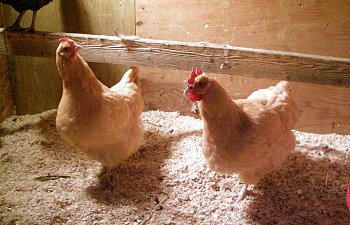
Leaves
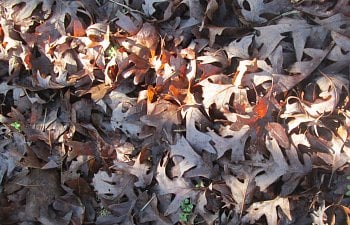
Pros: Free and readily available, No dust.
Cons: blow around a lot, hard to clean up later.
Because they are free and almost everyone has them in their yard, leaves are a pretty obvious thing to
use for bedding. Problem is, they like to blow around. Put them on one end of your coop, and they will
soon be scratched to the lowest end. For runs though, a load of leaves can be very beneficial, as
the chickens love scratching in them, gobbling up the worms and slugs that inevitably will find.
Throw a hand full of leaves in your brooder and you will have very happy chicks.
Also, leaves are nice and comfy, great for nest boxes.
My rating
Interior: ★★
Exterior: ★★★
Nest boxes: ★★★★
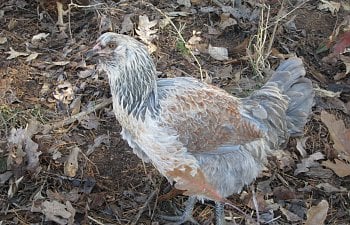
Wood chips
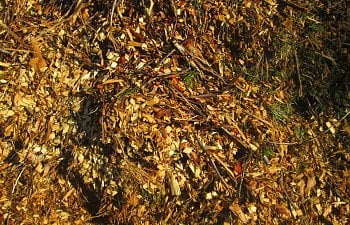
Pros: Cheap or free, no dust, absorbent, pest resistant.
Cons: Can be hard to find, hard to clean up later.
Wood chips or shredded trees, can make great bedding. They are dust free, and the chickens cannot
scratch them around like they can with other light materials like hay, leaves, or grass clippings.
Wood chips contain the whole tree, leaves, twigs and all, and makes fantastic mulch if let rot down. It is also great
for muddy pathways and runs. Finding wood chips can be hard. Your local electric company cuts and shreds
loads of wood chips every day if you are interested in getting large quantity's of them. Since wood chips are often
filled with large sticks and twigs, they are not good for nest boxes.
My rating
Interior: ★★★★★
Exterior: ★★★★★
Nest boxes: ★
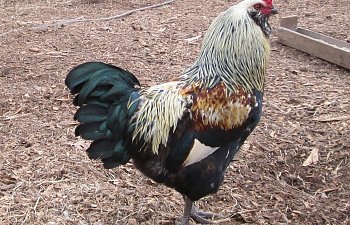
Grass clippings
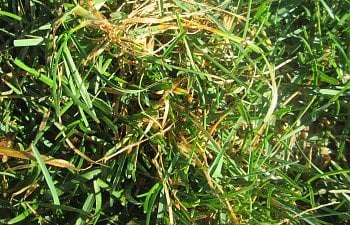
Pros: Free, smells good, chickens favorite.
Cons: Tough grasses can get stuck in chickens throats.
Grass clippings can be great bedding for your coop. Especially since chickens love to scratch and eat them
too. And they are free. Do not use clippings from tough grasses such as broom sedge or Fesque though,
as it can get stuck in your birds throats. Also, NEVER use clippings from grass that has been treated
with chemical fertilizers and pesticides, as it can be harmful or deadly to your birds.
My rating
Interior: ★★★
Exterior: ★★★
Nest boxes: ★★
Special thanks to Mountain peeps for letting me use her pictures!
Click here for part 2: https://www.backyardchickens.com/a/bedding-part-2-maintaining-your-bedding
Thanks for reading!

 Informative, simple, to the point. I appreciate this and will come back to this for future reference as my chicks get older.
Informative, simple, to the point. I appreciate this and will come back to this for future reference as my chicks get older.